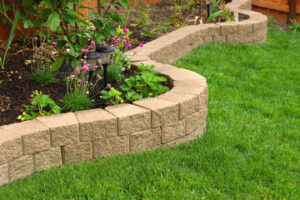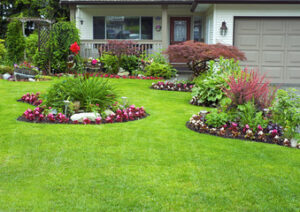Oceanic Landscaping is the art and science of modifying the natural environment. It involves adding plants, changing the terrain and constructing structures.

Landscape design is the process of creating a beautiful and functional outdoor space that reflects your personality and lifestyle. A well-designed garden can boost your property value and increase your quality of life.
Color is a powerful element of any landscape design. Warm colors like reds and yellows create excitement, while cool colors like greens and blues offer a tranquil feel. It is also important to use different hues in harmony, rather than in contrast, to emphasize specific landscaping features.
The color theme of your landscaping can be influenced by several factors, including plant species, colors in mulch and rock, and the colors of hardscapes like patios and walkways. For example, a classic blue can be found in the fabric of umbrella canopies and furniture upholstery. This provides an easy way to introduce a fun new color into the garden without drastically altering the overall landscape color scheme.
Theme-based landscaping allows you to narrow down your aesthetic while maximizing your yard’s potential. However, it’s important not to overdo it with multiple themes as this can result in a hodgepodge effect. Instead, focus on cultivating unity within your space by repeating certain plant species throughout your landscaping and utilizing the same colors in hardscapes and planting edging. Then, select a few bolder or softer colors to accent the space with flowers and other foliage.
Texture
The physical texture of a plant and its features is an important aspect to consider when designing your landscape. It can evoke a sense of touch, as well as influence the perception of depth and space. For example, a landscape with lots of coarse textures may feel busy and chaotic, while a smooth or soft garden can provide a sense of tranquility and peace.
The textured surface of a plant can also vary depending on its size, shape, and color, as well as the light it’s viewed in. This enables you to use it to create contrast and variety in your garden. For example, the rough bark of a tree can play beautifully against the soft fronds of a delicate grass, or the rounded form of a boxwood hedge can contrast with the spiky silhouette of a yucca plant.
Like form, texture is one of the 10 key principles of landscaping and can be found in plants, hardscapes, and decorative elements. Using different textures in your garden adds a unique and inviting quality that makes it stand out from the rest.
Adding texture to your landscape can also be done with different materials, such as gravel, rocks, and mulch. These add visual interest and help maintain a healthy soil. You can also use different colors and sizes of gravel to create a more dramatic and eye-catching effect.
Other texture-enhancing features include the shape of a plant or its leaves, flowers, and twigs. This can be rounded, blunt, or pointed and influences the overall composition of a garden. For instance, the rounded and smooth forms of ornamental grasses and shrubs can offer a calm and serene aesthetic, while pointed forms of plants like heuchera and sago palms provide drama and intrigue.
Light
Whether highlighting architectural features, accenting garden beds, or creating a warm ambiance for gatherings, landscape lighting transforms your property after dark. It accentuates elements you may have overlooked during the day, and it improves safety and security by illuminating pathways, stairs, and other features of your outdoor space.
A variety of fixtures are available, allowing you to achieve the desired lighting effect for your unique space. One technique is uplighting, which involves placing a fixture close to an object and pointing it upward to highlight the feature. This technique also creates a silhouette, which is useful for drawing attention to tall plants or structures. Downlighting is similar to uplighting but produces the opposite effect by illuminating the ground below an object.
Another option is washing, which entails flooding a surface with light to illuminate it and its surroundings simultaneously. This technique works well for large areas that need to be well lit, such as a dining or entertainment area. Washing is especially effective for hardscapes such as retaining walls and concrete pillars.
To maximize the effectiveness of your lighting, consider working with a professional to design and install your lighting setup. They can offer advice based on their experience, and they will ensure that your fixtures are properly placed and maintained for optimal functionality and beauty.
Proper maintenance is also essential to keep your landscape uplighting looking its best, so be sure to clean up debris or dust regularly. It is also important to replace bulbs and other components promptly, as these items can lose their functionality over time. This simple, yet vital step in the upkeep of your landscape lighting will keep your space functional and beautiful for years to come.
Space
A well-designed landscape can increase the value of a property, promote healthy lifestyles, and create beautiful outdoor spaces. The art of landscaping isn’t just about aesthetics; it also includes environmental and functional considerations, like preventing soil erosion and creating usable areas.
Lines are important in defining a space and establishing its character. Straight lines have a structural, forceful feel and are often associated with formality and symmetrical design. Curved lines, on the other hand, have a more organic, relaxed look and are often found in natural settings. The type of lines used in a landscape can impact how people use the area.
Plants are an essential part of any landscaping project, and they can serve a variety of purposes. For example, trees provide shade and improve air quality, while hedges can be used for privacy and to create boundaries. Hedges and other plants can also serve as habitats for birds and wildlife.
In addition to plants, landscaping also involves non-living elements, or hardscape, such as patios, walkways, and retaining walls. Hardscapes can help create designated spaces for entertaining or relaxing and provide a sense of unity and balance to the overall design. They can also be used to control erosion and manage water runoff.
The most common form of landscaping is residential, focusing on the creation of comfortable outdoor living spaces for family and friends. However, commercial landscaping can be just as effective. A well-designed landscape can boost the curb appeal of a business, and create a welcoming environment for employees and customers. Some common commercial landscaping features include:
Water
Landscapers incorporate many water-conserving strategies into their designs. By understanding a plant’s particular watering requirements and the impact of evapotranspiration, they can minimize the need for watering. They can also use a variety of methods to conserve, redistribute and reuse water. These include irrigation using timers or sensors that detect evapotranspiration, and minimizing the use of fertilizers. They can also install low-water plants, and create a xeriscape or drought-tolerant garden that requires significantly less water.
Landscape design features that incorporate water, such as fountains and ponds, can add interest and visual appeal to the yard. They can also serve practical purposes like reducing erosion and providing shade. Water features are also easy to maintain, and provide a soothing sound and a cool environment.
Trees are an important part of any landscaping project. Not only do they offer beauty and shade, but they can be used for privacy and security, and help to reduce energy costs. Landscapers can choose the right trees for each location in the landscape, making sure that they are the correct size and species for the space.
Landscaping also involves the creation of outdoor living spaces, such as patios and decks. These can be made from a variety of materials, and they are often incorporated into the overall design of the landscaping. Landscapers can also construct structures like fences and walls, as well as install hardscaping elements such as retaining walls and driveways.
Water conservation in landscaping is essential for financial and environmental sustainability. It reduces the demand for potable water, and decreases the cost of water treatment and distribution. It also helps to preserve natural water ecosystems and prevents runoff that carries soils, pesticides, fertilizers and other pollutants into lakes, rivers and streams.
